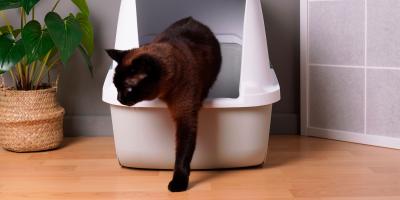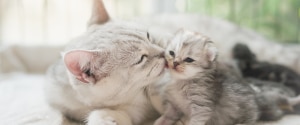
Tiny kittens are truly adorable. They’re fuzzy, they’re affectionate and they trip every nurturing trigger in us. Good kitten health doesn’t happen by accident: it starts in utero — and that’s where you come in. If you know how to tell if your cat is pregnant, you can keep mama kitty safe, comfortable and well nourished during her pregnancy and beyond.
In this article, we’ll explore the signs a cat is pregnant and we’ll talk about how long a cat is pregnant for. Then, we’ll give you some tips to help you take care of your feline friend.
Cat Pregnancy 101
Some cat pregnancies are planned while others happen unexpectedly. Cats are “in heat” or “in season” about once every three weeks. If an amorous tom comes along while your gal is in a period of peak fertility, kittens usually arrive about nine weeks later.
Like human pregnancies, cat pregnancies aren’t a to-the-day thing. Female cats — also known as queens — usually give birth between 63 to 67 days after becoming pregnant. Sometimes, though, kittens turn up on day 61. They also occasionally stay put until day 72.
Queens don’t generally show any signs of pregnancy until they’re a few weeks into their term. Next, we’ll explore some physical feline pregnancy symptoms to look out for.
How to Tell If Your Cat Is Pregnant: Typical Symptoms
Is your mama cat carrying kittens? Here are seven signs she might be pregnant:
- Morning sickness: Your cat vomits, just like a mama human.
- Weight gain: If your cat gains weight quickly, she may be pregnant. In total, gestating felines gain between 1 and 2 kg during pregnancy.
- Increased appetite: Pregnant cats eat a lot of food, so if your kitty is especially hungry, she could be expecting.
- Pinking up: About 15 to 18 days into your cat’s pregnancy, her nipples will begin to enlarge, and they’ll also get more red.
- Swollen tummy: In tandem with other symptoms, a swollen tummy is one of the most obvious signs of feline pregnancy.
- Maternal behaviours: Pregnant queens often display maternal behaviours — they purr more and demand more attention from you.
- Positive ultrasound: Some vets offer ultrasound exams. If you see kittens on the screen, your cat is pregnant.
If you feel your mama cat is vomiting too much, or if her tummy swells and you don’t suspect pregnancy, take her to the veterinarian as soon as possible.
Note: Eating a lot can also mean worms, so if your cat isn’t pregnant and she’s mowing through her Purina Cat Chow, take her to your vet for an examination.
Cat Labour Signs
The big day is upon you — or is it? Here are five reliable signs that your cat is in labour:
- Your mama cat stops eating, fidgets a lot and starts looking for a place to bed down.
- Your cat’s body temperature drops to about 37.8ºC.
- She starts to get vocal or begins to wash herself constantly.
- You notice abdominal contractions or discharge.
- Kittens begin to emerge.
If your cat’s discharge is black or bloody, give your vet a call right away.
Quick-Reference Troubleshooting
Most of the time, cat pregnancies progress without any issues. Sometimes, however, problems do occur. Learn about pregnancy, labour and postpartum trouble spots to stay prepared.
Cat Pregnancy
Call your veterinarian if your mama cat displays any of the following symptoms during pregnancy:
- She completely loses interest in eating.
- She’s visibly distressed, or she licks her vulva repeatedly but no kittens emerge.
- You notice foul-smelling or abnormal discharge — or any bleeding.
- She passes blood in the litter box or pees more than usual.
Peeing more than usual — or passing blood — can indicate a uterine infection, which needs prompt attention and treatment.
Cat Labour
If you notice any of these issues during your cat’s labour, it’s time for a professional helping hand:
- No kittens arrive within 3 or 4 hours of the beginning of labour.
- You think there are kittens still inside your queen 24 hours after the beginning of labour.
- She has strong contractions for more than an hour without producing a kitten.
- She delivers fewer placentas than kittens.
- She can’t expel a kitten.
If there are fewer placentas than kittens, your queen might have a retained placenta. Untreated, this can lead to severe infection, so call your vet right away.
After Birth
Most queens do well after giving birth. If any of the following problems occur, get in touch with your vet ASAP:
- Your cat trembles or seems agitated — those are both potential symptoms of low calcium and eclampsia.
- She’s still straining after you’re sure all her kittens have been born.
- She doesn’t seem interested in her food.
- Smelly discharge, or discharge containing fresh blood.
- Firm, red or clearly painful mammary glands.
- Smelly or brown discharge from your mama cat’s nipples.
- Kittens that don’t gain weight and don’t appear to thrive.
A Better Cat Pregnancy With Purina
Healthy queens produce healthy kittens — so the sooner you find out your cat is pregnant, the better. Signs of cat pregnancy include vomiting, maternal behaviour, weight gain and increased appetite. As labour draws nearer, your female cat might refuse food, get fidgety, wash herself and meow more.
Cat pregnancies usually go off without a hitch. Problems do sometimes occur, though, including eclampsia, retained placentas and infection. Keep your vet’s phone number close at hand in case you need to make an emergency call.
Great nutrition is important, especially in pregnancy. Purina foods, including Purina ONE premium cat food, provide a well-balanced blend of nutrients to help keep your mama cat healthy.
Related articles



